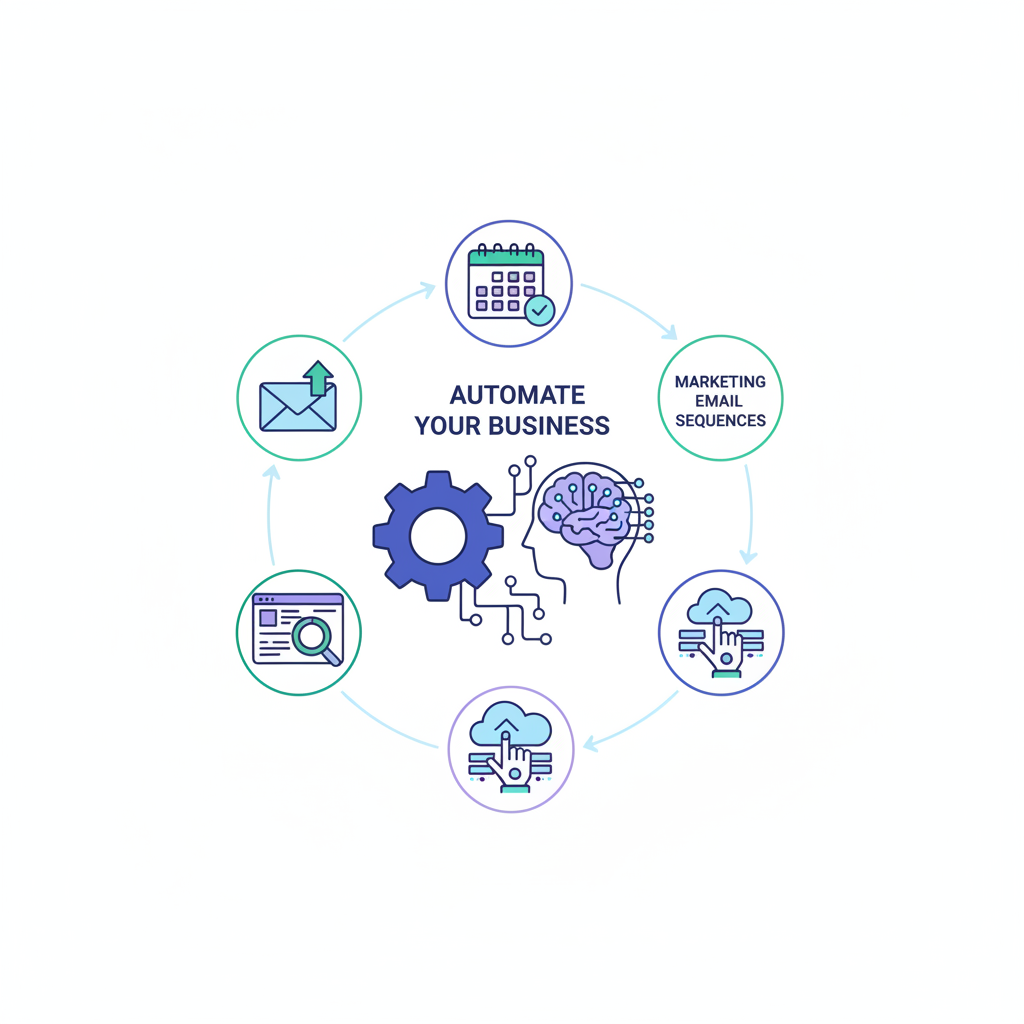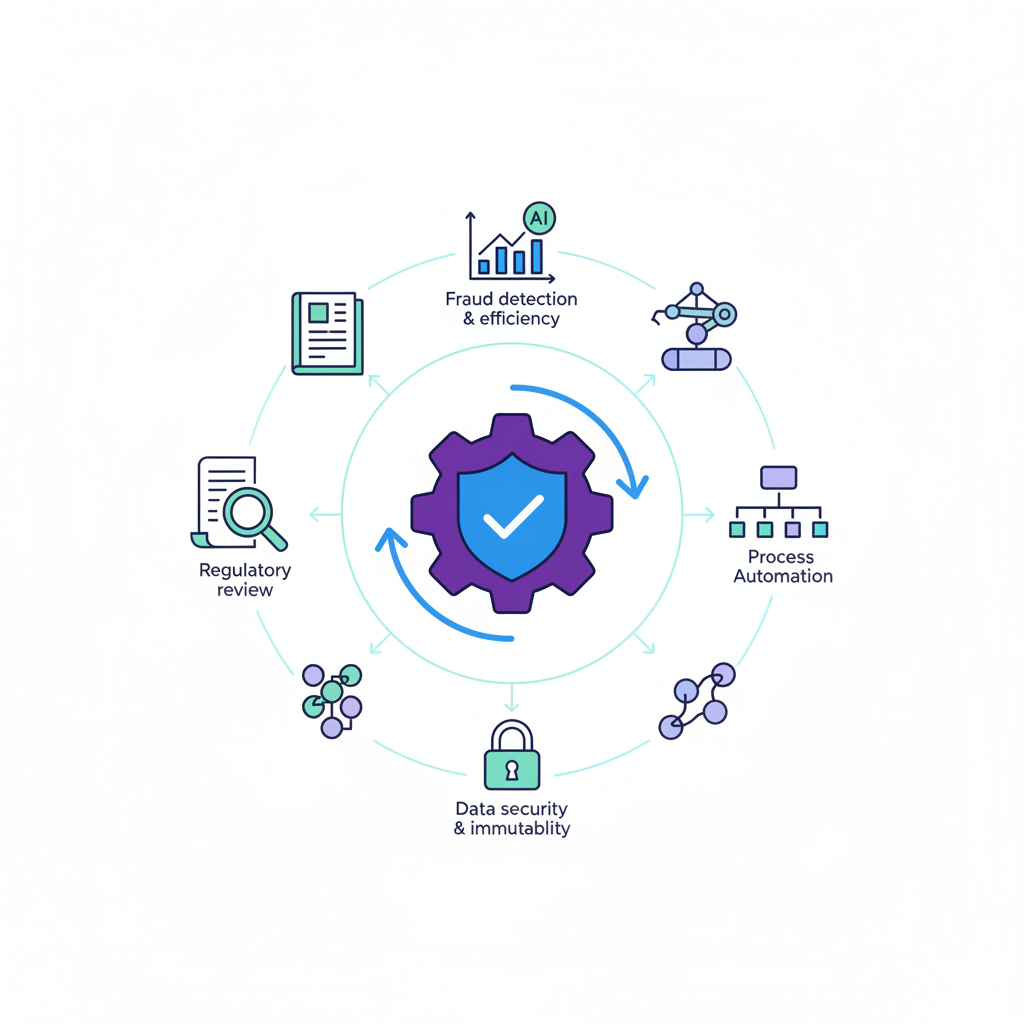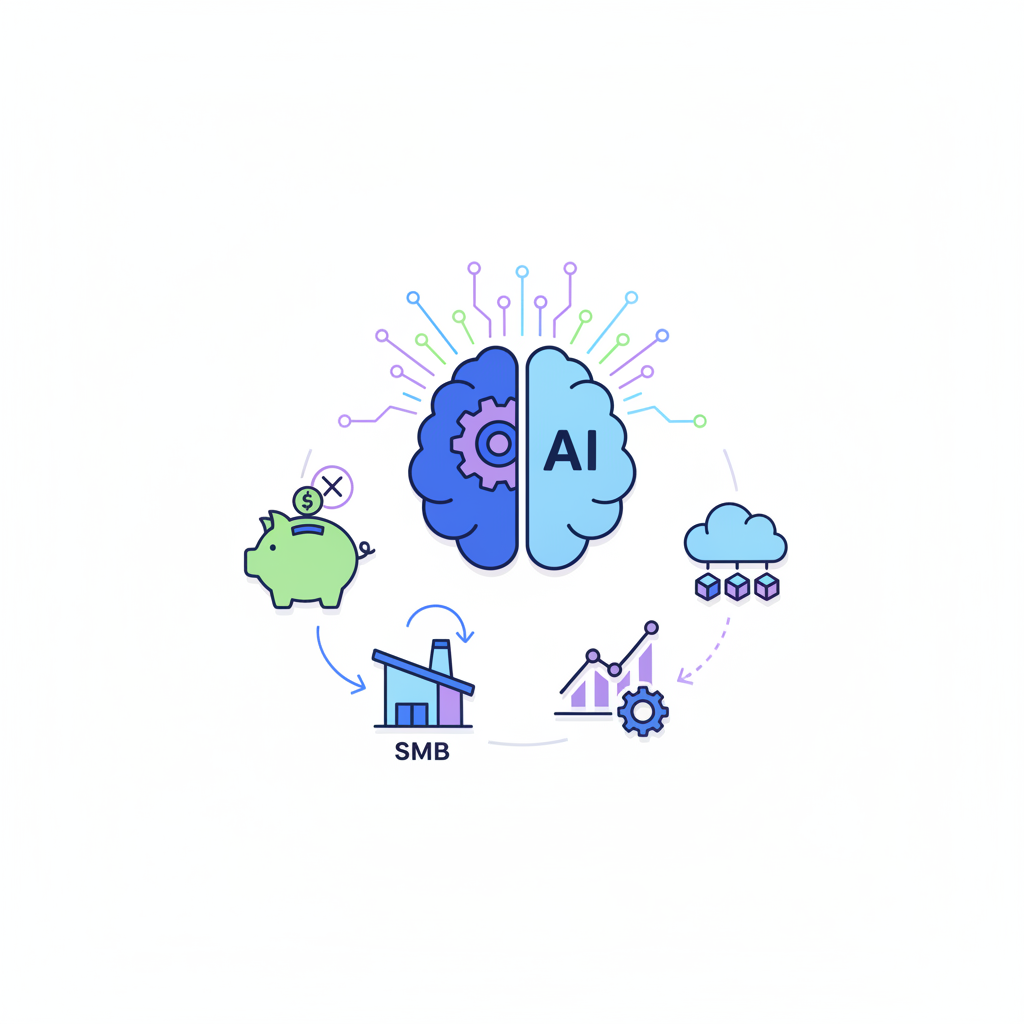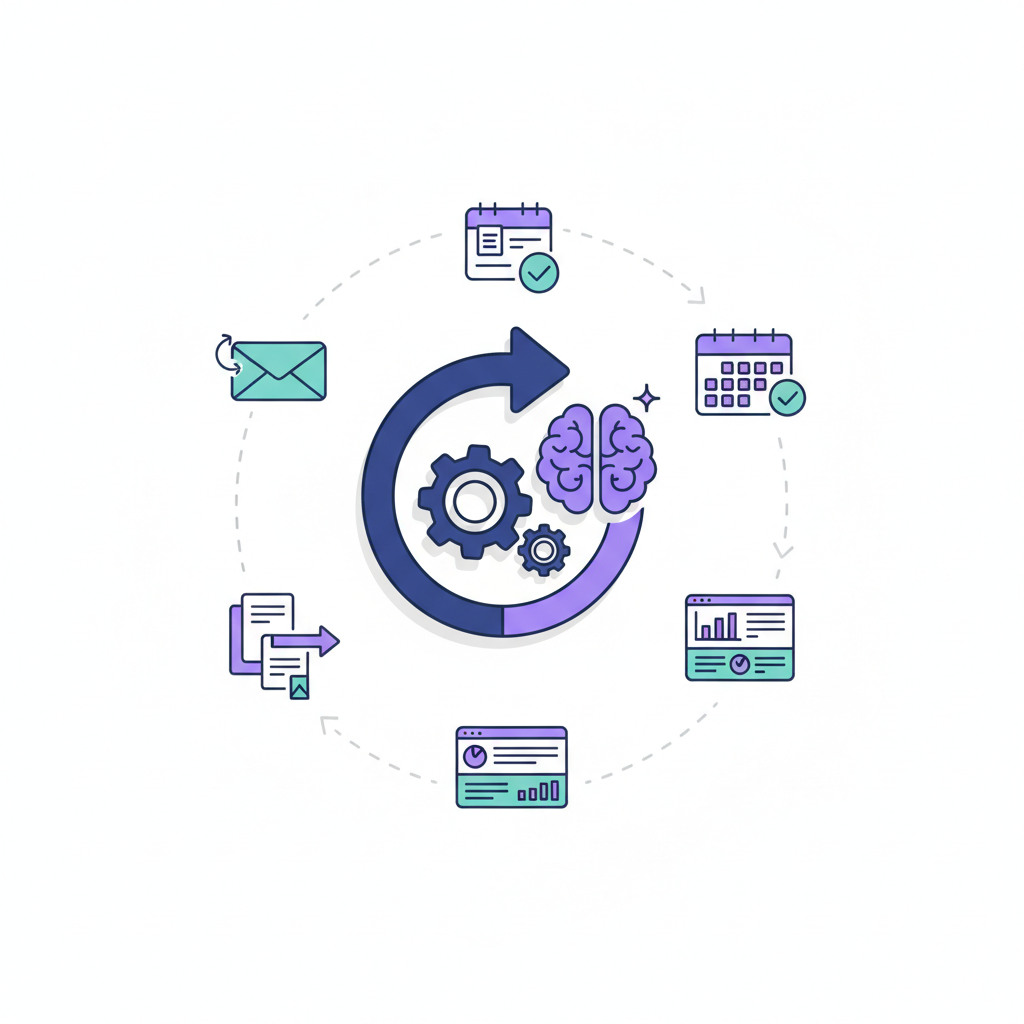Unlock Efficiency: Simple Ways to Automate Your Business with AI Today
In today's hyper-competitive business landscape, the pressure to operate with peak efficiency and maintain a significant competitive edge has never been greater. Businesses of all sizes are constantly seeking innovative strategies to streamline operations, reduce costs, and enhance customer satisfaction. However, for many business owners and decision-makers, the concept of Artificial Intelligence (AI) often conjures images of complex, futuristic technologies that are beyond their immediate grasp or budget. This perception can lead to a sense of overwhelm, making the idea of integrating AI into daily operations seem like a daunting, far-off endeavor. The reality, however, is far more accessible and immediate.
AI is no longer a futuristic dream; it is an accessible, immediate solution for business automation that can be implemented today with surprising simplicity. This article aims to demystify AI, presenting it not as a complex, high-tech challenge, but as a practical, readily available suite of tools designed to boost your business efficiency and productivity right now. We will explore how to automate business with AI through simple, actionable strategies that require minimal technical expertise. The goal is to highlight current, readily available AI solutions and their immediate benefits, moving beyond future predictions to focus on tangible, present-day applications.
Throughout this guide, we will delve into seven simple ways AI can automate business processes, from enhancing customer interactions to optimizing internal workflows. You'll discover how AI automation tools can transform various aspects of your operations, making your business more agile, responsive, and profitable. By embracing AI in business, you're not just adopting new technology; you're unlocking a new level of operational excellence and strategic advantage. Prepare to learn how to leverage AI business automation to achieve significant gains in productivity and overall performance, starting today.
Why Automate Your Business with AI? The Immediate Benefits for Today's Businesses
The decision to embrace AI automation is not merely about adopting new technology; it's a strategic move that delivers a multitude of immediate and tangible benefits for businesses navigating today's dynamic market. One of the most compelling advantages is the significant increase in productivity. By offloading repetitive, time-consuming tasks to AI, human resources are freed up to focus on more strategic, creative, and high-value activities that require critical thinking and emotional intelligence. This reallocation of effort directly contributes to greater operational excellence and overall business efficiency.
Beyond productivity gains, AI solutions for business offer substantial cost reduction. Automating processes minimizes the need for manual labor in routine tasks, thereby reducing operational expenses. Furthermore, AI's ability to process vast amounts of data without human bias or fatigue leads to enhanced accuracy, drastically minimizing errors that can be costly in terms of time, resources, and reputation. This precision ensures that tasks are completed correctly the first time, every time.
The impact on customer experience is equally profound. AI-powered systems can provide faster responses, offer personalized interactions, and deliver consistent support around the clock, leading to higher customer satisfaction and loyalty. In an era where customer expectations are constantly rising, this capability is invaluable. Ultimately, by adopting modern AI automation, businesses gain a significant competitive advantage. Staying ahead means embracing innovation, and leveraging AI for business automation positions your company as forward-thinking and efficient, ready to meet the demands of the modern economy.
7 Simple Ways to Automate Your Business with AI Tools
The promise of AI automation is not just for tech giants; it's a practical reality for businesses of all sizes looking to enhance efficiency and productivity. This section will introduce seven actionable methods, demonstrating how simple it can be to integrate AI tools into your existing workflows. Each method emphasizes ease of adoption, proving that you don't need to be an AI expert to start leveraging the power of these transformative technologies today. These AI automation examples showcase real-world applications that can deliver immediate value.
1. Automating Customer Support with AI Chatbots
Automating customer support with AI chatbots is one of the most straightforward and impactful ways to implement AI business automation. What makes it simple is its ability to provide 24/7 instant support, handling a vast array of frequently asked questions (FAQs), guiding customers through common issues, and even qualifying leads without requiring constant human intervention. This ensures that your customers receive immediate assistance, regardless of the time zone or day, significantly improving their experience and reducing the burden on your human support team. It’s a prime example of how to automate business with AI to enhance service delivery.
Implementing this simply involves a few key steps. First, choose a user-friendly AI automation tool or platform that offers chatbot functionalities. Many platforms provide intuitive interfaces that don't require coding knowledge. Next, define your common queries and the corresponding answers. This can often be done by analyzing your existing customer support tickets or FAQ pages. Then, train the bot with this existing data, allowing it to learn and improve its responses over time. Finally, integrate the chatbot with your website, messaging apps like Facebook Messenger, or even your internal communication channels.
Recommended AI tools: Intercom, Tidio, and HubSpot Chatbot. The benefits are clear: improved response times, a significant reduction in support costs, and a consistent, high-quality customer experience that operates around the clock. These AI automation examples demonstrate immediate value.
2. Streamlining Content Creation & Marketing with AI
Streamlining content creation and marketing with AI represents a powerful application of AI automation, making it incredibly simple to boost your digital presence. The beauty of this approach lies in its ability to generate a wide range of content ideas, draft compelling social media captions, craft engaging email subject lines, and even produce full articles or blog posts with remarkable speed and consistency. This capability allows businesses to maintain a vibrant and active online presence without the extensive time and resource investment traditionally required for content generation, making AI in business a game-changer for marketing teams.
Implementing this simply involves leveraging AI writing assistants. The process typically begins by providing the AI tool with a clear prompt or a few keywords related to your desired content. For instance, you might ask it to “write a blog post outline about sustainable fashion” or “generate five catchy headlines for a new product launch.” The AI then processes this input and generates various content options. Your role is to review and refine the output, ensuring it aligns with your brand voice and specific marketing goals. Once refined, the content can be scheduled for publication across your chosen platforms. This creates efficient AI workflows for marketing.
Recommended AI tools: Jasper AI, Copy.ai, and Surfer SEO. The benefits are substantial: a dramatic increase in content output, improved SEO performance through keyword-rich and well-structured content, and the ability to maintain a consistent brand voice across all marketing channels, ultimately enhancing overall business automation.
3. Enhancing Data Analysis & Reporting with AI Insights
Enhancing data analysis and reporting with AI insights offers a simple yet profound way to automate business processes with AI, transforming raw data into actionable intelligence. What makes this approach so accessible is AI's unparalleled ability to quickly identify trends, uncover anomalies, and extract meaningful, actionable insights from vast and complex datasets. This is achieved without the need for complex manual analysis, which often requires specialized skills and significant time investment. AI-powered tools can process information far beyond human capacity, providing a clear picture of your business performance and market dynamics, thereby driving business efficiency.
To implement this simply, the first step is to connect your chosen AI analytics tools to your existing data sources. These sources can include your Customer Relationship Management (CRM) system, sales data, marketing campaign performance, website analytics, and financial records. Most modern AI business automation platforms offer straightforward integrations with popular business applications. Once connected, you can set up customized dashboards that visualize key metrics and allow the AI to automatically generate reports. Your role then becomes interpreting these AI-generated reports, which often highlight critical areas for attention or opportunities for growth, enabling data-driven decisions.
Recommended AI tools: AI features within Google Analytics, Tableau, and Microsoft Power BI. The benefits are immense: faster, more accurate data-driven decisions, the power of predictive analytics to anticipate future trends, and a significant boost in overall business efficiency and operational excellence by turning data into a strategic asset.
4. Optimizing Sales & Lead Generation with AI
Optimizing sales and lead generation with AI is a highly effective AI automation use case that simplifies and supercharges your revenue-generating efforts. What makes this approach simple is AI's capacity to intelligently identify high-potential leads, personalize outreach messages at scale, accurately predict sales outcomes, and automate crucial follow-up sequences. This means your sales team can focus their valuable time and energy on engaging with prospects who are most likely to convert, rather than sifting through unqualified leads or manually managing repetitive communication tasks. It's a direct application of how to automate business with AI for tangible results.
Implementing this simply involves integrating AI sales tools with your existing Customer Relationship Management (CRM) system. This integration allows the AI to access and analyze your customer data, historical interactions, and lead behavior. Based on this analysis, you can define lead scoring criteria, enabling the AI to rank leads by their likelihood to convert. Subsequently, you can automate personalized email sequences and follow-up reminders, ensuring no lead falls through the cracks. Regularly analyzing the performance metrics provided by the AI tools will allow you to refine your strategies and continuously improve your sales funnel.
Recommended AI tools: Salesforce Einstein, HubSpot Sales Hub, and Apollo.io. The benefits are substantial: significantly higher conversion rates, a reduced sales cycle due to more efficient lead nurturing, and a massive boost in productivity for sales teams, making AI solutions for business indispensable for growth.
5. Automating Administrative Tasks & Scheduling
Automating administrative tasks and scheduling with AI offers a remarkably simple yet profoundly impactful way to enhance business efficiency and free up valuable time for strategic work. What makes this approach so accessible is AI's ability to effortlessly manage complex calendars, schedule meetings with multiple participants across different time zones, accurately transcribe meeting notes, and intelligently organize documents. These are often the mundane, repetitive tasks that consume a significant portion of an employee's day, and AI can handle them with speed and precision, directly contributing to increased productivity.
Implementing this simply involves leveraging readily available AI assistants and integration platforms. For scheduling, tools like Calendly, with its AI-powered scheduling capabilities, can automatically find the best meeting times based on participants' availability and send out invitations. For transcription, services like Otter.ai can listen to meetings (live or recorded) and provide accurate, searchable transcripts, eliminating the need for manual note-taking. For document organization, you can set up automated categorization rules using AI integrations through platforms like Zapier, which connects various apps to create seamless AI workflows for automating business tasks.
Recommended AI tools: Calendly, Otter.ai, and Zapier. The benefits are clear: significant time savings for individuals and teams, a drastic reduction in administrative burden, and a noticeable improvement in overall business efficiency, allowing employees to focus on higher-value activities.
6. Improving Inventory Management & Supply Chain with AI
Improving inventory management and supply chain with AI is a critical AI business automation strategy that offers profound benefits for businesses dealing with physical goods. What makes this approach simple is AI's capacity to accurately predict demand fluctuations, optimize stock levels to prevent both overstocking and stockouts, identify inefficiencies within the supply chain, and even automate reordering processes. This level of precision and foresight is virtually impossible to achieve with traditional manual methods, making AI automation examples in this domain particularly impactful for operational excellence.
To implement this simply, the first step involves integrating AI inventory software with your existing Enterprise Resource Planning (ERP) or inventory management systems. This integration allows the AI to access historical sales data, supplier lead times, seasonal trends, and other relevant information. Once integrated, you feed this historical data into the AI system, which then uses advanced algorithms to forecast future demand. Based on these predictions, you can set up automated alerts for low stock levels and even configure the system to trigger automated reorder points with your suppliers, streamlining the entire procurement process. This is a powerful way to automate business processes with AI.
Recommended AI tools: Lokad, EazyStock, and Blue Yonder. The benefits are substantial: reduced waste due to optimized stock levels, improved cash flow by minimizing capital tied up in excess inventory, enhanced delivery times to customers, and overall operational excellence that boosts profitability and customer satisfaction.
7. Personalizing Customer Experience with AI Recommendations
Personalizing customer experience with AI recommendations is a highly effective AI automation use case that directly impacts customer engagement and loyalty. What makes this approach simple is AI's ability to deliver tailored product recommendations, suggest relevant content, and present personalized offers based on individual user behavior, preferences, and historical interactions. This moves beyond generic marketing, creating a unique and highly relevant experience for each customer, making them feel understood and valued. It's a prime example of how to automate business with AI to foster deeper customer relationships.
Implementing this simply involves utilizing AI recommendation engines and integrating them with your existing e-commerce platform, Customer Relationship Management (CRM) system, or content management system. The process begins with collecting user data – this includes browsing history, purchase history, items viewed, search queries, and demographic information (with appropriate privacy considerations). The AI engine then analyzes this data to build individual customer profiles and predict what products or content they are most likely to be interested in. Once the engine is trained, you can deploy these personalized experiences across various touchpoints, such as website product carousels, email marketing campaigns, or in-app suggestions.
Recommended AI tools: Dynamic Yield, Optimizely, and Recombee. The benefits are significant: increased customer engagement as users find exactly what they're looking for, higher conversion rates due to relevant offers, improved customer loyalty through a personalized journey, and a strong demonstration of the power of AI in business to drive customer-centric growth.
Getting Started with AI Automation: Your First Simple Steps
Embarking on your AI automation journey doesn't have to be an overwhelming leap; it can be a series of simple, manageable steps that yield immediate benefits. The key lies in choosing the right AI tools for your business and understanding how to navigate common challenges. For businesses new to AI automation, minimal technical expertise is often needed, thanks to the proliferation of user-friendly platforms.
Choosing the Right AI Tools for Your Business:
Start by assessing your specific business needs and identifying the areas where automation would provide the most significant impact or relieve the greatest pain points. Don't try to automate everything at once. Instead, start small with one or two high-impact areas, like customer support or content generation, as discussed in the previous sections. Look for user-friendly interfaces, often referred to as no-code or low-code options, which allow you to set up and manage AI workflows without extensive programming knowledge. Consider scalability – choose tools that can grow with your business and integrate well with your existing systems. Many AI business automation platforms offer free trials, allowing you to test their efficacy before committing. This approach to getting started with AI automation minimizes risk and maximizes learning.
Overcoming Common Challenges & Pitfalls:
One of the most frequent hurdles is data quality issues. AI thrives on good data, so before implementing any AI automation tools, take the time to clean your data. Ensure it's accurate, consistent, and complete. Another common challenge is resistance to change within your team. Address this by clearly communicating the benefits of AI automation – how it frees up employees from mundane tasks, allowing them to focus on more creative and rewarding work. Highlight that AI is a tool to augment human capabilities, not replace them. Integration complexities can also arise, especially if you have many disparate systems. To mitigate this, start with simple integrations between a few key tools and gradually expand. Finally, budget concerns are always a factor. Focus on high-ROI areas first, where the cost savings or revenue generation from AI automation will quickly justify the investment. Remember, the goal is to make AI work for you, not the other way around.
Measuring Success: Simple Metrics for Your AI Automation Efforts
Once you've implemented AI automation, understanding its impact is crucial for continuous improvement and demonstrating value. Measuring success doesn't require complex analytics; simple, clear metrics can effectively track the return on investment (ROI) for your AI automation initiatives and highlight areas for further optimization. This approach ensures that your AI workflows are truly contributing to business efficiency.
Key Performance Indicators (KPIs):
To gauge the effectiveness of your AI automation, focus on KPIs directly related to the automated processes. For instance, if you've automated customer support, track the time saved by your human agents, the reduction in average response times, and improvements in customer satisfaction scores (CSAT). For content creation, monitor the increase in content output and any improvements in SEO rankings or website traffic. In sales, look at conversion rate improvements and the reduction in the sales cycle length. Across the board, track cost reduction by minimizing manual labor and error rate decrease in automated tasks. These metrics provide a clear picture of how AI automation is positively impacting your operations.
Calculating ROI:
Calculating the ROI of AI doesn't have to be complicated. A simple method involves comparing the costs associated with implementing and maintaining your AI automation (software subscriptions, integration costs, training) against the quantifiable benefits. For example, if an AI chatbot saves your business 20 hours of human support time per week, multiply those hours by the average hourly wage of your support staff to estimate the cost savings. Add any increases in revenue directly attributable to AI (e.g., higher conversion rates from AI-personalized recommendations). Subtract the AI costs from these benefits, and divide by the AI costs to get your ROI percentage. This straightforward calculation helps justify further investment and identify the most impactful AI automation initiatives.
Iterate and Optimize:
The journey with AI automation is iterative. Use the insights gained from your KPIs and ROI calculations to refine your AI workflows. If a particular automation isn't performing as expected, analyze the data to understand why and make adjustments. Perhaps the AI needs more training data, or the workflow needs tweaking. Continuously optimize your AI solutions based on performance metrics, and don't hesitate to expand automation to other areas once you've seen success in your initial implementations. This iterative process ensures that your AI automation efforts consistently drive business efficiency and deliver maximum value.
Embrace the Future: Simple AI Automation for Your Business Today
The landscape of modern business is constantly evolving, and the imperative to remain agile, efficient, and competitive has never been stronger. As we've explored, AI business automation is not a distant, complex concept reserved for tech giants; it is an accessible and immediate solution for businesses of all sizes, offering tangible benefits that can be realized today. The power of AI to transform operations, enhance customer experiences, and drive growth is within reach, requiring far less technical expertise than many might assume.
We've delved into 7 simple ways to automate business with AI, showcasing practical applications that can be implemented with readily available AI automation tools. From revolutionizing customer support with AI chatbots that provide instant, 24/7 assistance, to streamlining content creation and marketing with AI writing assistants, the opportunities are vast. We've seen how AI can enhance data analysis for smarter decision-making, optimize sales and lead generation for increased revenue, and even automate mundane administrative tasks and complex inventory management. Finally, the ability of AI to personalize customer experiences ensures deeper engagement and loyalty.
The message is clear: the time to leverage AI in business is now. Don't let perceived complexity deter you. We encourage you to start small, perhaps by implementing just one simple automation discussed in this guide. Choose an area where you feel the most pain or see the clearest opportunity for improvement. The immediate benefits—increased productivity, reduced costs, enhanced accuracy, and improved customer satisfaction—will quickly become apparent, building momentum for further AI adoption. AI is not a future concept; it is a present-day tool for growth and efficiency, ready to empower your business to thrive in the digital age. Embrace the future, today.








